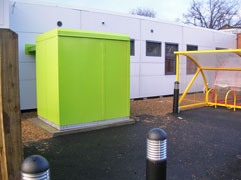Ground Source Heat Pumps
Ground source heat pumps work by absorbing heat from the ground and transferring the heat into buildings – to heat the buildings without burning fossil fuels.
The heat pump itself is located in the building and works on the same principles as a domestic fridge: the heat pump in a fridge transfers heat out of the fridge and uses a heat exchanger to disperse the heat from a small radiator at the back of the fridge into the room.
A ground source heat pump absorbs heat from the ground – by circulating water though piping in the ground – and transfers the heat into the building by circulating hot water though radiators, or underfloor piping circuits.
The heat pump is able to increase the temperature it receives from the ground before circulating it into the house. It does this by compressing refrigerant gases. When a large volume of gas is compressed into a small space the heat energy in the gas becomes concentrated – the gas becomes very hot. The heat pump uses a heat exchanger to transfer that heat to the heating circuit in the building.
After the high pressure gas has yielded up its heat, the pressure of the gas is released and it then becomes very cold. The heat pump uses a heat exchanger to transfer that cold to the ground loop circuit. As the cold water is circulated through the ground it absorbs heat from the surrounding ground and the cycle can begin again.
Design of GSHP installations is critical
A Ground Source Heat Pump (GSHP) can be an efficient means of saving money and saving carbon emissions if carefully designed for space heating of an appropriately designed building.
The first priority should be to ensure that the building is well insulated (and well managed). All new buildings should have high insulation built in and be well constructed to minimise heat loss through air leaks.
Because a GSHP is more efficient when producing a lot of warmth – as opposed to a small amount of heat – the distribution system in the building should match this: a large area of underfloor heating distributing warmth is more efficient than a small area of radiators emitting high temperatures (and causing draughts).
Coefficient of Performance – CoP – GSHP
The key to the efficiency of a GSHP is the Coefficient of Performance: the “CoP”. In spite of the first law of thermodynamics, which tells us that energy can neither be created nor destroyed, a GSHP in a good installation can yield up to four units of heat for each unit of electricity consumed. The heat pump is not creating this energy, but merely separating a medium temperature from the ground into warmth (which can be used for heating) and cold (which can be returned to the ground).
The CoP will vary with each installation, but the lower the output temperature to the heat distribution system the higher the CoP will be. If an output temperature of 60°C is needed to heat radiators the CoP is likely to fall to level of only 2.5. If the heat distribution is to a well designed underfloor heating system that works well at an output temperature of 40°C then the CoP can rise to a level of 4.
The input temperature is also critical to the CoP of the heat pump. The higher the input temperature from the ground, the lower the amount of work needed from the heat pump, the higher the CoP will be. In fact, the critical factor is the “uplift” between the source temperature and the output temperature.
Heat moves very slowly in the ground
Normally a GSHP starts with a ground temperature of about 10°C: this is the natural temperature of the ground at a depth of six metres. This temperature of around 10°C will be found across Great Britain, summer or winter, unless unusual conditions apply. The reason is that heat only moves very slowly in the ground.
Unusual conditions will be found where a heat pump is in action: as a heat pump draws heat from the ground the ground temperature will fall from the natural level of 10°C to a lower level (which depends on the amount of heat drawn from the ground and the volume of ground from which it is extracted).
As the ground temperature gets colder the heat pump will have more work to do to deliver the output temperature required for heating. In these conditions the CoP of the heat pump will fall below the rule of thumb figure, often given, of 4. If asked to extract heat from ground which is too cold, the ground source heat pump will "Lock Up".
The CoP is critical because, although a heat pump can be efficient, electricity is more expensive than gas. If you do not get a high CoP from your heat pump it could be cheaper to use a gas boiler for heating. In terms of carbon saving a heat pump releases no CO2 on site, but you should consider the CO2 emitted at the power stations to create the electricity you use.

Interseasonal Heat Transfer and GSHPs
ICAX has introduced a radical new mechanism for collecting surplus solar heat in the summer, storing it in Thermalbanks, and releasing it via heat pumps to heat buildings in winter: Interseasonal Heat Transfer.
By using ThermalBanks for thermal energy storage ICAX enables its heat pumps to start with a ground temperature of 25°C, instead of starting with an autumn ground temperature of 10°C. This doubles the CoP of the heat pump from the standard figure of 4 up to 8 and transforms the economics, and carbon saving, of using a GSHP.
Seasonal Performance Factor - SPF
In practice the CoP of a standard heat pump across the winter season can fall from 4 to below 3 as the ground gets colder. Similarly, the seasonal CoP of an ICAX system will fall from the autumn level of 8 to 5.5 as heat is extracted from the ThermalBank. This is referred to as the “Seasonal Cop” (SCoP), the “Seasonal Performance Factor” (SPF) or the “Seasonal Energy Efficiency Ratio” (SEER).
A standard GSHP extracts energy from a slinky pipe buried in the ground at a depth of around two metres and lowers the temperature in the ground. Eventually heat from the surrounding ground will migrate back to the “heat overdraft” created. Ultimately this energy comes from the sun.
Where land is limited a ground source heat pump can be linked to vertical boreholes which extract heat from depths of down to 150 metres. These boreholes can be expensive and may require consent from water authorities. The energy taken from these boreholes is also replenished ultimately from the sun, although the term “geothermal energy” is often used, as if the heat source were the earth's core temperature. The source of energy is still the sun, but the earth provides the valuable function of storing energy.
Thermal Energy Storage
ICAX takes advantage of these properties of the earth to store energy. ICAX collects surplus solar energy in summer and stores it in ThermalBanks in advance of the heating season. Most of the heat energy provided by Interseasonal Heat Transfer comes directly from the sun, with a little help from a Ground Source Heat Pump.
See also: GSHP Breakthrough
See also: Banking on IHT
See also: Renewable Cooling
See also: Ground Source Energy
See also: Professor David MacKay endorses heat pumps
See also: RHI - Renewable Heat Incentive



